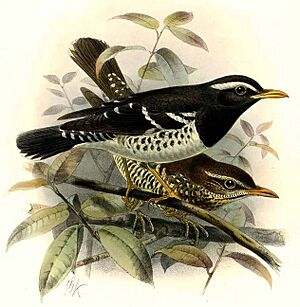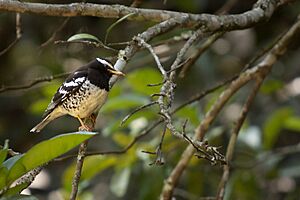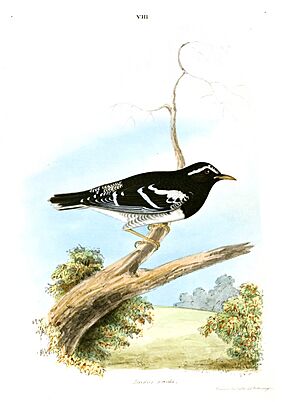Pied thrush facts for kids
The pied thrush (Geokichla wardii) is a cool bird that belongs to the thrush family. You can find them in India and Sri Lanka. Male pied thrushes are easy to spot because they have striking black and white patterns. Females, on the other hand, are olive-brown with speckles. These birds spend their summers breeding in the central Himalayan forests. When winter comes, they fly south to the hill forests of southern India and Sri Lanka. Like many other thrushes, they look for food among the fallen leaves on the forest floor. If something scares them, they quickly fly into trees and stay very still, making them hard to see!
Quick facts for kids Pied thrush |
|
|---|---|
 |
|
| Illustration by John Gerrard Keulemans | |
| Conservation status | |
| Scientific classification | |
| Genus: |
Geokichla
|
| Species: |
wardii
|
| Synonyms | |
|
Zoothera wardii |
|
What Does the Pied Thrush Look Like?
Male pied thrushes are about 22 centimeters (about 8.7 inches) long. They have very clear black and white markings. Their upper body is mostly black. They have a long white stripe above their eye, like a white eyebrow. Their wing feathers, rump, and tail also have white tips.
The underside of the male bird is white with black spots on its sides. Both its beak and legs are yellow. Female and young pied thrushes have a similar pattern. However, their black parts are dark brown, and their white parts are light brown. The spots on their underside look more like scales.
The pied thrush's beak is not as curved as some other thrushes. Female pied thrushes also do not have a light-colored cheek spot. This spot is seen on the similar-looking female Siberian thrush.
The scientific name wardii honors Samuel Neville Ward (1813–1897). He was a British administrator who worked in India. Mr. Ward was known for studying nature and for his artistic skills. He even corresponded with famous scientists like Charles Darwin.
Thomas C. Jerdon, a naturalist, was one of the first to get a specimen of this bird. He noted that this "Pied Blackbird" was found in the Himalayas. It also spent winters in the plains of India. He first got a specimen from Mr. Ward near the Neilgherries.
For a long time, the pied thrush was placed in the Zoothera group of thrushes. But in 2008, scientists used new studies to sort out bird families. They found that the pied thrush belonged to an older group called Geokichla. Birds in the Geokichla group often have very different looks between males and females. The pied thrush's closest relative is the Siberian thrush.
Where Do Pied Thrushes Live?
Pied thrushes breed in the summer, from May to July. Their summer breeding range stretches from western Himachal Pradesh in the Himalayas to at least central Nepal. Some records from further east have been questioned.
These birds are migratory, meaning they travel long distances. They spend their winters mainly in Sri Lanka. Smaller numbers also winter in the hills of southern India. During their long journey, they can sometimes be hunted by crows.
Even though they are rare, you can regularly see them in certain places during winter. For example, many birds gather by the stream at Victoria Park in Nuwara Eliya, Sri Lanka, early in the morning. They are also seen in some hill stations in southern India, like Nandi Hills and Yercaud.
Behaviour and Life Cycle
Pied thrushes usually look for food alone or in pairs. You can often see them on the ground. If they are disturbed, they fly into trees and stay very still. This makes them hard to spot. Like many thrushes, pied thrushes can be quite secretive.
These birds are omnivores, meaning they eat both plants and animals. However, they eat more insects than fruit. In winter, they sometimes form loose groups with other thrushes.
The breeding season for pied thrushes is from May to July. They build a deep, cup-shaped nest. They line it with grass and use mud to make it strong. The nest is usually placed in a low fork of a tree. A female pied thrush lays 3 to 4 eggs. These eggs are either white or bluish.
This uncommon bird breeds in the Himalayas at heights between 1,500 and 2,500 meters (about 4,900 to 8,200 feet). They prefer thick woodlands for breeding. Their wintering areas are similar but can include areas with fewer trees. These winter spots are generally at altitudes of 750 to 1,500 meters (about 2,460 to 4,900 feet).
Their song is not as musical as some other thrushes. It usually sounds like a series of squeaky notes followed by short trills.




